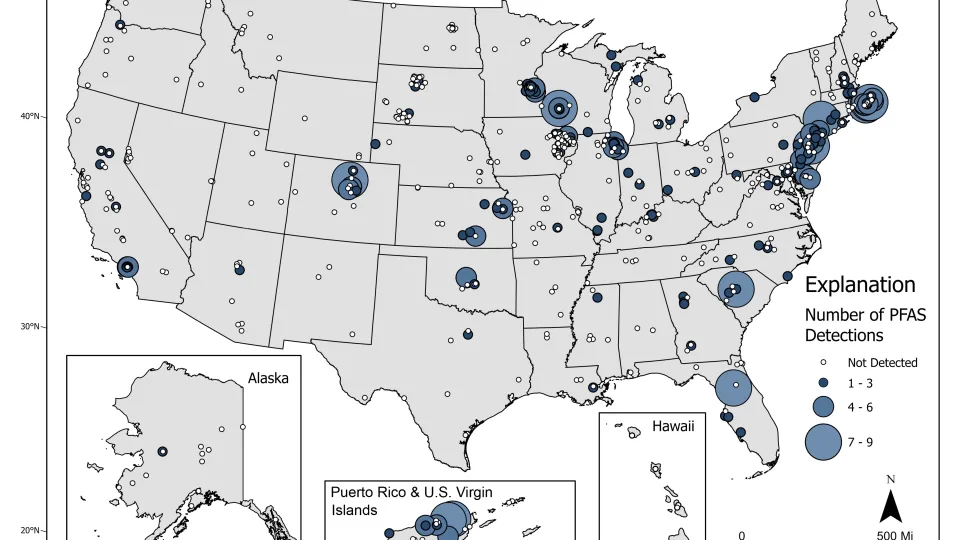A new government study conducted by the US Geological Survey (USGS) has found that nearly half of the tap water in the United States contains toxic chemicals known as PFAS (per and polyfluorinated substances).
These synthetic compounds, commonly referred to as “forever chemicals,” have been linked to various health problems, including cancer.
The study, which is the first of its kind to examine PFAS contamination in both private and regulated tap water sources nationwide, highlights the widespread presence of these chemicals in drinking water across large cities, small towns, and private wells.
The Extent of Contamination

This map from USGS shows the number of PFAS detected in tap water samples from select sites across the US
The USGS study reveals that PFAS chemicals are contaminating drinking water in varying degrees across the country, affecting both private wells and public water systems.
The samples were collected between 2016 and 2021 from 716 locations, including residences, schools, offices, and various geographical areas.
The study’s findings estimate that at least one type of PFAS chemical could be detected in approximately 45% of tap water samples nationwide.
Types of PFAS Detected
Out of the 32 detectable PFAS compounds, the study identified the most frequently found to be PFBS, PFHxS, PFOA, and PFOS.
Some samples contained up to nine different varieties of PFAS chemicals.
The median concentration of PFAS chemicals in the tested tap water was approximately seven parts per trillion, while the proposed EPA limit for PFOA and PFOS is four parts per trillion.
Health Risks and Concerns
Studies on lab animals have suggested potential links between PFAS chemicals and various health issues, including cancers, high blood pressure, low birth weight, and other adverse effects.
The presence of these chemicals in drinking water raises concerns about the long-term health risks posed to individuals who consume contaminated water.
Researchers and health experts emphasize the need for further studies to better understand the extent of the health risks associated with PFAS exposure and the development of comprehensive regulations to limit public exposure.
Regional Variations in Contamination
The USGS study revealed significant regional variations in PFAS contamination levels.
The heaviest PFAS contamination was observed in urban centers and areas near potential sources of the chemicals, such as the Eastern Seaboard, Great Lakes, Great Plains, and Central/Southern California.
Conversely, many rural areas showed no detectable levels of PFAS. These findings suggest a higher likelihood of PFAS exposure for individuals residing in urban areas.
Efforts to address contamination should consider the specific challenges faced by different regions and prioritize areas with higher contamination levels.
Implications and Recommendations
The USGS study emphasizes the importance of testing private well water for PFAS contamination and considering the installation of filtration systems to remove these harmful chemicals.
Activated carbon or reverse osmosis membranes are effective methods for filtering PFAS contaminants from drinking water.
The study also highlights the need for increased public awareness about PFAS contamination and its potential health risks.
Individuals must take proactive measures to protect their drinking water and seek information from local and state authorities regarding testing and treatment options.
Government Regulation and Responsibility
The study raises concerns about the lack of regulation regarding the use of PFAS chemicals by companies and their disposal in public wastewater systems.
Advocacy organizations, such as the Environmental Working Group, call for holding polluters accountable and addressing the issue at its source to prevent further contamination of water supplies.
Efforts should focus on developing and implementing comprehensive regulations that restrict the use and disposal of PFAS chemicals, as well as establishing stricter controls on industrial practices that contribute to PFAS contamination.
Taking action is more important than ever
The comprehensive USGS study sheds light on the extent of PFAS contamination in tap water throughout the United States.
The widespread presence of these “forever chemicals” and their potential health risks underscore the urgent need for action to ensure the safety of the public water supply.
Efforts should focus on regulating the use and disposal of PFAS chemicals, as well as providing resources for individuals to test and treat their drinking water.
This includes the implementation of filtration systems and raising public awareness about the importance of monitoring and addressing PFAS contamination.
By taking proactive measures and holding polluters accountable, we can work towards safeguarding our water sources and protecting the health of communities across the nation.










